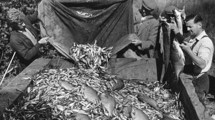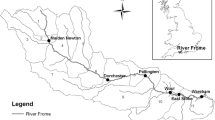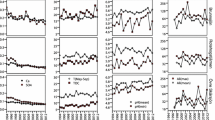Abstract
This work exemplifies how a given lake (Lake Huljesjön, Sweden) would likely respond to changes in pH-values and to liming (a standard measure against anthropogenic acidification). The basic questions are: How would a liming influence pH? How long would the changes last? How would the changes influence the structure and function of lake ecosystems? The work uses a comprehensive lake ecosystem model, LakeWeb, which accounts for production, biomasses, predation, abiotic/biotic interactions of nine key functional groups of organisms, phytoplankton, bacterioplankton, two types of zooplankton (herbivorous and predatory), two types of fish (prey and predatory), zoobenthos, macrophytes and benthic algae. LakeWeb is a dynamic model and gives weekly variations. It has been critically tested using empirical data and regressions from many lakes. Those tests are not presented here but have shown that the model can capture typical functional and structural patterns in lakes very well. This gives credibility to the results presented in this work, which would be very costly to obtain in the traditional manner by extensive field studies in one or a few lakes. This work presents for the first time predictions at the ecosystem level of how functional groups of organisms (and not individual species) are likely to respond to acidification and liming. Two existing dynamic models, one for liming, the other for Hg-concentrations in fish, have been added to the LakeWeb-model. These two models have previously been tested and proven to yield good predictions. The results presented here indicate that there are several probable changes in the structure and function of the lake foodweb related to acidification and liming. The predicted changes in macrophyte cover will influence the predation pressure on fish, and thereby the fish biomass. Reductions in primary production at low pH-values will cause reductions in fish biomass. There are several interesting compensatory effects between factors that increase fish biomass and factors that tend to decrease the biomass. Such matters can be handled quantitatively by the LakeWeb-model.
Similar content being viewed by others
References
Ambio, Special issue on acid rain, 5(5-6) 1976.
W. Dickson, Critical loads for nitrogen on surface waters, in: Critical Loads for Nitrogen and Sulphur, ed. J. Nilsson (Nordiska ministerrådet, Miljörapport, 1986) pp. 201-210.
G. Likens, R. Wright, J. Galloway and T. Butler, Acid Rain. Sci. Am. 241 (1979) 43-51.
L. Granath, Våtdeposition av kväveföreningar (wet deposition of nitrogen), in: Processer i kvävets kretslopp (Processes in Nitrogen Circulation), ed. T. Rosswall (Swedish Environmental Protection Agency, PM 1213, Stockholm, 1980) pp. 47-59.
L. Håkanson, The quantitative impact of pH, bioproduction and Hgcontamination on the Hg-content in fish (pike), Environmental Pollution 1 (1980) 285-304.
L. Håkanson, Water Pollution-Methods and Criteria to Rank, Model and Remediate Chemical Threats to Aquatic Ecosystems (Backhuys, Leiden, 1999) 299 p.
L. Håkanson, P. Andersson, T. Andersson, Å. Bengtsson, P. Grahn, J.-Å. Johansson, H. Kvarnäs, G. Lindgren and Å. Nilsson, Measures to reduce mercury in lake fish, Final report from the Liming-Mercury-Cesium project. Swedish Environmental Protection Agency, PM 3818, Stockholm (1990) 189 p.
L. Håkanson and V. Boulion, The Lake Foodweb-Modelling Predation and Abiotic/Biotic Interactions (Backhuys, Leiden, 2002) 344 p.
L. Håkanson and R.H. Peters, Predictive Limnology. Methods for Predictive Modelling (SPB, Amsterdam, 1995) 464 p.
L. Henrikson and Y.W. Brodin, eds., Liming of Acidified Surface Waters. A Swedish Synthesis (Springer-Verlag, Berlin, 1992) 458 p.
R.J.M. Hudson, S.A. Gherini, C.J. Watras and D.B. Porcella, Modeling the biogeochemical cycle of mercury in lakes: The mercury cycling model (MCM) and its application to the MTL study lakes, in: Mercury Pollution. Integration and Synthesis, eds. C.J. Watras and J.W. Huckabee (Lewis, Boca Raton, 1994) pp. 473-523.
O. Lindqvist, K. Johansson, M. Aastrup, A. Andersson, L. Bringmark, G. Hovsenius, L. Håkanson, Å. Iverfeldt, M. Meili and B. Timm, Mercury in the Swedish environment, Water, Air and Soil Pollution, 55 (1991), 261.
Monitor, Acidification and liming of Swedish freshwaters, Swedish Environmental Protection Agency, Solna (1991) 144 p.
Å. Nilsson, Statistical modelling of regional variations in lake water chemistry and mercury distribution. Thesis, Umeå Univ., Sweden (1992).
S. Odén, Nederbödens och luftens försurning-dess orsaker, förlopp och verkan i olika miljöer (Acidification of precipitation and air-causes, processes and consequences in different environments), Ekologikommittén, Bull. No. 1 (1968) NFR.
F. Ottosson and L. Håkanson, Presentation and analysis of a model simulating the pH response of a lake liming, Ecol. Modelling 105 (1997) 89-111.
H.M. Seip, ed., Acid precipitation. Literature review, Nord. Council of Ministers, Nord 1989:37, Copenhagen (1989) 209 p.
C.J. Watras and J.W. Huckabee, eds., Mercury Pollution. Integration and Synthesis (Lewis, Boca Raton, 1994) 727 p.
Author information
Authors and Affiliations
Rights and permissions
About this article
Cite this article
Håkanson, L. Consequences and Correctives Related to Lake Acidification, Liming and Mercury in Fish – A Case-Study for Lake Huljesjön, Sweden, Using the LakeWeb-model. Environmental Modeling & Assessment 8, 275–283 (2003). https://doi.org/10.1023/B:ENMO.0000004581.41692.af
Issue Date:
DOI: https://doi.org/10.1023/B:ENMO.0000004581.41692.af




